Table of contents
- Top test: KTM 1190 Adventure Rally Express
- Braking and steering behavior
- engine and gears
- Anti-lock braking system
- Technical specifications
- Competitive model
- Scoring / conclusion
- Conclusion
- Used KTM 1190 Adventure in price comparison
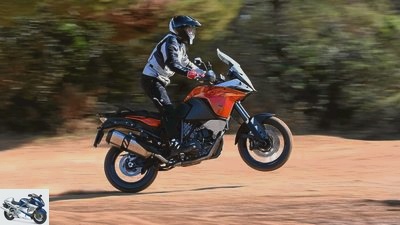
Jahn
motorcycles
Single test of the KTM 1190 Adventure
Top test: KTM 1190 Adventure
Rally Express
From scratch, with a powerful boost in performance and the latest electronics, the KTM 1190 Adventure reaches for the crown of travel enduros.
Andreas Bildl
02/28/2013
It’s all about the travel enduros, one novelty follows the other. Ducati is giving the Multistrada the partially active Skyhook chassis, Triumph is renovating the Tiger gang (see driving report, p. 28), BMW is launching the top dog GS with a water boxer (see top test, p. 10). And want at the same time KTM with the 1190 Adventure give the competition a mess. The KTM is clearly approaching its plan to lead the pack from the sporty corner. Crisp, almost slim for a travel enduro, it stands on the main stand – which is only available in the electronics package (800 euros) together with the electrically adjustable chassis and tire pressure monitor. The editorial scales reported 238 kilograms with a full 23 liter tank. Not bad. And the whole thing is powered by 150 hp. With this, the KTM ranks together with the Multistrada at the top in terms of performance and weight, at least in terms of paper form.
The KTM counteracts the low single-digit temperatures of the night by spontaneously starting work at the push of a button. Full and self-confident, it thunders out of the single silencer at just over 2000 rpm. With a noticeable thump, first gear engages, and the day can come. Even the first few meters lift the mood considerably. A seat height of 86 centimeters in the lower of two steps is not an insurmountable hurdle. The ergonomics are excellent: hip and knee angles relaxed, the upper body upright, the butted aluminum handlebars – like the footrests adjustable in two positions – are not too wide and are easy to reach.
Buy complete article
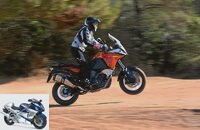
Top test: KTM 1190 Adventure
Rally Express
8 pages) as PDF
€ 2.00
Buy now
You can approach the young day calmly and go through the innovations in your mind again. The wheel sizes have shrunk from 21 (front) and 18 inches (rear) to 19 and 17. They have the newly developed ContiTrailAttack 2 with the special code “K”, the first enduro tires with ZR code for speeds over 240 km / h – which KTM is supposed to do still manage 250. The spring travel was cut by 20 millimeters. The new, 9.8 kg lightweight tubular space frame now houses the 1190 cm3 twin from the superbike RC8 R, which has been prepared for its new purpose with a few changes. It is kept under control by a traction control (MTC), which has a 40 gram Bosch lean angle sensor of the very latest generation and works depending on the lean angle. Also new is the Bosch Combi ABS (C-ABS) with lift detection for the rear wheel, in which the handbrake lever also decelerates the rear wheel.
In addition to the four injection driving modes Sport, Street, Rain and Offroad on board: the optional electrically adjustable chassis. The electronics provide the right suspension set-up for the respective driving mode. Depending on the load on the shock absorber, the preload can be adjusted at the push of a button. Of course, driving and suspension modes can also be freely combined. Sounds complicated, but thanks to a clever operating concept, it’s child’s play to use. The wealth of information in the clearly legible cockpit is enormous. Range, outside and oil temperature, consumption, battery voltage, driving time and, and, and. The engine is warm, the clutch can be pulled as smooth as butter, one gear after the other slips precisely and easily. The V2 roars through the alleys of the southern French villages in a fun-loving manner. In the lower gears it accelerates to just over 2000 rpm without jerking, and in the upper gears its comfort zone starts at 3500 rpm. Underneath it, it shakes noticeably, especially under load. But its true nature only comes to the fore from this speed mark. Up to 3500 rpm the V2 works cautiously, but then it tightens the muscles and pulls horse and rider forward with vigor. Pulls through powerfully, winds up enthusiastically and lightly, puts, Vrroap, another briquette at 6000 / min. Magnificent revving, robust sound, the V2 cannot deny its sporty genes. Sure you can also stroll around with him. However, he prefers and masters the sporty start, lustfully pushing forward from curves. Does not release his performance too aggressively and easily dosed, rushes purposefully to the limiter. With a measured 147 HP, the Adventure stands perfectly in the forage. Nevertheless, it has not increased its torque in any speed range compared to the base RC8 R. But in conjunction with the shorter overall ratio, it delivers excellent pulling power.
The technicians succeeded in tuning the ride-by-wire. The 1190 gets down to business in the apex of the curve without annoying load change jerks and hangs nicely on the gas. The twin runs surprisingly cultivated, only drums noticeably from 6000 rpm in notches and handlebar ends.
Braking and steering behavior
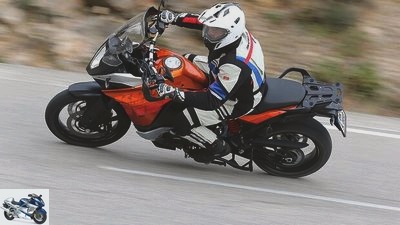
Jahn
The design of the Adventure no longer seems so uncompromising and unmistakable.
If you grasp it too roughly by the horns at the end of the curve, the traction control (MTC) intervenes and reduces the power by intervening in the throttle valve. This also prevents the front wheel from rising. If you want to enjoy the dynamics of the V2 unrestrained and have no objection to one or the other wheelie, you have to switch off the MTC.
In any case, the chassis copes perfectly with the sporty pace. The Adventure is extremely stable, especially in road mode and especially in sport mode. And even in the comfort setting, it doesn’t sway through the curves like a junk in heavy seas. On the other hand, it does not offer the dignified long-distance comfort of touring sedan chairs. The shock absorber does not respond sensitively enough for this, and the thin seat cushion is not of great help when filtering minor degrees of hardness. The bandwidth of the setting range should therefore be a little wider in the direction of comfort.
On the other hand, the KTM is not an uncompromisingly tough goat because of its sporty attitude. The fork does its job quite well with good response and sufficient damping, only dives quickly and far during hard braking maneuvers. The KTM sails imperturbably through smooth and undulating curves, and neither bumps nor the grip on the brakes can noticeably detract from the course. The brembos do not startle with lightning-like grabs, at first they bite gently, but carefully and with increasing hand strength, really bearishly.
When the brakes are applied hard, the 1190 seems a bit restless, but the ABS controls confidently along the grip limit and enables crisp, short braking distances. No question about it, the Adventure is in its element on winding roads. Steers not hyper-agile, but willing, is calm and uncomplicated. Only the first turn from the middle position requires a clear impulse. Relaxed wagging is a little lacking in the casual, self-evident fact that the KTM does not necessarily focus on the point. Which is probably due to the tightly acting steering damper and a steering head bearing that is a little too tightly preloaded. After consulting the factory, KTM wants to change this in series production immediately, and MOTORRAD will check it out in the next comparison test. But the Adventure runs straight ahead. Bolt without batting an eyelid with full sails over our furrowed kickback test track.
A small off-road area on the side of the road beckons you to take a detour – why not? After all, this is where the Adventure has so far had its strengths. The new one can also easily be directed over the loose surface. Thanks to ABS, the KTM decelerates vehemently here too. In off-road mode, the traction control on the rear wheel allows twice the speed of the front wheel, which enables clean drifts. Although the tight off-road suspension setting increases the spring preload for more bottom-through reserves at the rear, the spring elements lock up even with slight jumps. And the Conti-TrailAttack 2 are quickly at the end of their game on the loamy ground. But for serious off-road riding, KTM finally has the R version with 21/19-inch wheels.
The remaining range display reminds you to go to the petrol pump. 5.6 liters are not a brilliant achievement, the new model does not fulfill hopes for lower consumption. But with a tank volume of 23 liters, there are still 400 kilometers in it. The Adventure also offers many other practical details. For example, the pannier racks are integrated nicely and inconspicuously, and refilling the oil is very simple thanks to the extended nozzle. On-board socket and switch for the (optional) seat heating are easily accessible. The windshield offers good wind protection and can be adjusted in height by 25 millimeters without tools, but hardly while driving. However, not everything looks as well thought-out as, for example, with the RC8 R. The height of the shift lever can only be roughly adjusted using the toothing of the shift shaft, the headlight range adjustment is not accessible without tools, and changing the detent position requires dismantling the same.
Rather incidental, because the summary is extremely positive: the new Adventure has gained around 80 points compared to its predecessor, and now belongs to the elite club of machines with more than 700 points. This will not only heat up the sporty competition. That promises excitement before the first comparison.
engine and gears
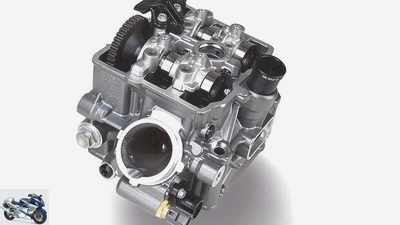
Jahn
Revised cylinder heads with two different spark plugs that have separate maps.
With a whole range of measures, the sports unit from the RC8 R was domesticated for use in the travel enduro. Fortunately, it has also improved its running smoothness.
The adventure motor is based on the RC8 R unit, but has a modified housing with an oil sight glass. The most significant changes, of course, took place inside. Changed camshafts and valve timing reduce the power from 175 to 150 hp. Narrower inlet ducts and longer intake funnels should ensure a uniform torque curve. Due to the lower maximum speed, steel instead of titanium inlet valves can be used. The crank mechanism remained unchanged. In addition to the oil level sensor, the new features include the gear stepping with shorter lower gears and the FCC anti-hopping clutch with servo function, which reduces the manual effort required.
Anti-lock braking system
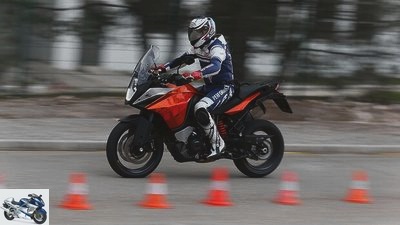
Jahn
The KTM masters the jump in the coefficient of friction with ease.
When it comes to ABS, KTM uses the latest technology. The Bosch 9ME system is currently the latest version. The system works as a combination brake system (C-ABS), in which the rear brake is actuated with the handbrake lever; the brake pedal, on the other hand, only works at the rear. Two different braking modes are available: Street and Offroad. The latter has to be activated separately, it tolerates more slip on the front wheel and completely switches off the ABS function at the rear. In off-road terrain, this coordination enables robust deceleration. However, stoppies are then also possible. In road mode, the system ensures excellent braking values. At full deceleration, the fork plunges deeply and the KTM sometimes seems restless, but the tail always remains reliably on the ground and thus gives the driver security, because neither a lift-off tail nor a temporarily locking front wheel causes moments of shock. This also applies to the tricky jump in the friction coefficient when braking over alternating non-slip surfaces – in this case two prepared sand fields. The ABS is also convincing here, regulating quickly and sensitively. The front wheel does not lose grip on the sand that suddenly appears. The deceleration values are excellent in both cases and testify to a successful coordination.
Technical specifications
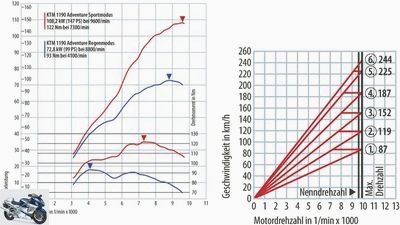
archive
KTM 1190 Adventure performance diagram.
Performance
Top speed * 250 km / h
acceleration
0-100 km / h 3.7 sec
0-140 km / h 5.6 sec
0-200 km / h 10.9 sec
Draft
60-100 km / h 3.6 sec
100-140 km / h 3.6 sec
140-180 km / h 4.1 sec
Speedometer deviation
Effective (display 50/100) 49/99 km / h
Tachometer deviation
Display red area 10 100 / min
Effective 10,000 rpm
consumption
Country road 5.6 l / 100 km
At 130 km / h 6.3 l / 100 km
Theor. Range of the country road 411 km
Fuel type super
Dimensions + weights
L / W / H 2255/840/1485 mm
Seat height 860-875 m
Handlebar height 1145 mm
Turning circle 5720 mm
Weight with a full tank 238 kg
Payload 202 kg
Wheel load distribution v / h 49/51%
Competitive model
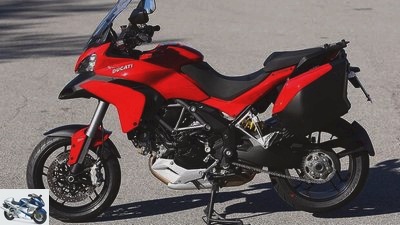
Jahn
One of the competing models: Ducati Multistrada 1200 S.
BMW R 1200 GS
Two-cylinder boxer engine, 125 hp, weight 246 kg, 0-100 km / h: 3.7 sec,
Vmax: 219 km / h,
Consumption 4.8 liters, ABS
14 480 euros *
Ducati Multistrada 1200 S.
Two-cylinder V-engine,
148 hp, weight 245 kg,
0-100 km / h: 3.3 sec,
Vmax: 245 km / h,
Consumption 5.4 liters, ABS
19 135 euros *
Triumph Tiger Explorer XC
Three-cylinder in-line engine, 137 hp, weight 271 kg, 0-100 km / h: 3.5 sec,
Vmax: 210 km / h,
Consumption 4.7 liters, ABS
15 320 euros *
* Additional costs included
Scoring / conclusion
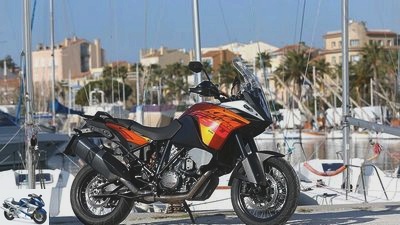
Jahn
The electronic settings of the 1190 Adventure can be freely combined. ABS and traction control can be switched off.
| maximum number of points | KTM 1190 Adventure | ||
| engine | |||
| Draft | 40 | 33 | With its lively and lively engine, the Adventure inspires particularly sporty natures on winding country roads. Especially since his manners, i.e. smooth running and load changes, are really successful. This also applies to the coordination of the ride-by-wire, the electronic throttle grip. And because the smooth clutch and the slippery gearbox are also pleasing, there is hardly anything to complain about except for its cautious acceleration below 3500 rpm. |
| acceleration | 40 | 29 | |
| Top speed | 30th | 23 | |
| Engine characteristics | 30th | 24 | |
| Responsiveness | 20th | 14th | |
| Load change | 20th | 14th | |
| Smoothness | 20th | 10 | |
| coupling | 10 | 9 | |
| circuit | 20th | 13th | |
| Gear ratio | 10 | 8th | |
| Start | 10 | 8th | |
| total | 250 | 185 | |
| landing gear | |||
| Handiness | 40 | 27 | It can rob bends, that is out of the question. Even if the tight steering damper and the steering head bearing, which was set tightly from the outset, resulted in deductions in steering behavior on the test machine. Neutral, stable, safe. And with plenty of lean angle. But it can also go straight ahead very well. Good conditions for long tours. Also for two, because the chassis can easily accommodate a pillion passenger. But comfort-conscious people will want a shock-absorbing strut that is easier to swallow and that works more sensitively. |
| Stability in curves | 40 | 28 | |
| Steering behavior | 40 | 24 | |
| feedback | 10 | 7th | |
| Inclined position | 20th | 16 | |
| Straight-line stability | 20th | 16 | |
| Suspension tuning in front | 20th | 14th | |
| Chassis tuning at the rear | 20th | 13th | |
| Adjustment options undercarriage | 10 | 8th | |
| Suspension comfort | 10 | 5 | |
| Driving behavior with a passenger | 20th | 15th | |
| total | 250 | 173 | |
| everyday | |||
| Ergonomics driver | 40 | 32 | Apart from the thin seat cushion, the pilot is well accommodated. This basically also applies to the pillion passenger. But his place is more likely designed for narrow butts. If you have more seat width, you can easily come into contact with the handles. Neat, but not a highlight: the windbreak, even with the windshield up. A third of the mirrors are occupied by the upper arms, but the KTM brings a decent amount of light. The complete equipment, the high payload and the long range should count even more for touring riders. |
| Ergonomics pillion | 20th | 14th | |
| Windbreak | 20th | 11 | |
| view | 20th | 10 | |
| light | 20th | 13th | |
| Furnishing | 30th | 30th | |
| Handling / maintenance | 30th | 19th | |
| Luggage storage | 10 | 5 | |
| Payload | 10 | 7th | |
| Range | 30th | 26th | |
| processing | 20th | 14th | |
| total | 250 | 181 | |
| security | |||
| Braking effect | 40 | 30th | A very strong chapter. The ABS-assisted brakes always go to work with confidence. The ABS set-up was really successful. In addition, the KTM hardly stands up when braking, even when it is inclined. And handlebar slap is not an issue thanks to the steering damper. |
| Brake metering | 30th | 22nd | |
| Braking with pillion passenger / fading | 20th | 14th | |
| Righting moment when braking | 10 | 8th | |
| ABS function | 20th | 16 | |
| Handlebar slapping | 20th | 18th | |
| Ground clearance | 10 | 8th | |
| total | 150 | 116 | |
| costs | |||
| guarantee | 30th | 17th | The greatly extended inspection intervals (15,000 km) are a pleasing cost-conscious fact and are worth a lot of points. However, the insurance and expensive ZR tires go into the money. |
| Consumption (country road) | 30th | 16 | |
| Inspection costs | 20th | 18th | |
| Maintenance costs | 20th | 7th | |
| total | 100 | 58 | |
| Overall rating | 1000 | 713 | In terms of price, the KTM is in the middle of the field, and the high number of points consequently leads to an excellent price-performance score |
| Price-performance note | Top grade 1.0 | 1.8 |
Conclusion
You have done a great job in Mattighofen: Compared to its predecessor, the new Adventure represents a huge step forward. The engine scores with powerful, lively, and the electronic helpers are perfectly coordinated. The seating position is successful, the in-house range of accessories is extensive. If you are looking for something to complain about: consumption, wind protection and suspension comfort could be even better.
Used KTM 1190 Adventure in price comparison
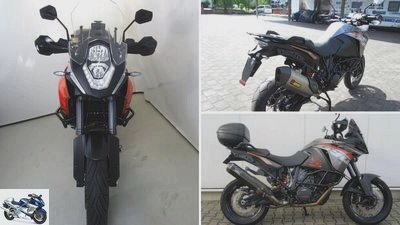
1000PS marketplace app
Used KTM 1190 Adventure in Germany.
the KTM 1190 Adventure is a popular motorcycle with customers and on the used market. The selection is diverse and the prices for used 1190 Adventure are very stable. Many examples are already equipped with case systems or KTM PowerParts. Here is the current market situation: used KTM 1190 Adventure in Germany.
Related articles
-
Track test Ducati 1198 S against KTM 1190 RC8 R.
Rossen Gargolov motorcycles Track test Ducati 1198 S against KTM 1190 RC8 R. Track test Ducati 1198 S against KTM 1190 RC8 R. New challenge KTM wants to…
-
MSC cornering ABS in the test in the KTM 1190 Adventure
Jahn motorcycles MSC cornering ABS in the test in the KTM 1190 Adventure MSC in the KTM 1190 Adventure put to the test ABS suitable for lean angles…
-
Pendulum test of KTM Adventure models
jkuenstle.de 45 pictures KTM 1/45 January 2013: It is already clear at the presentation – the new KTM is a great success. markus-jahn.com 2/45 July 2013:…
-
Comparison test Ducati 1098S, Honda Fireblade, KTM 1190 RC8, Triumph Daytona 675, Yamaha YZF-R6
Jahn motorcycles Comparison test Ducati 1098S, Honda Fireblade, KTM 1190 RC8, Triumph Daytona 675, Yamaha YZF-R6 Comparison test Ducati 1098S, Honda…
-
The endurance test of the KTM 790 Duke Adventure R
KTM motorcycles Enduro The endurance test of the KTM 790 Duke Adventure R KTM 790 Duke Adventure R in the intensive test Is it the most off-road daily…
-
Comparison test: Honda Hornet, Kawasaki Z 750, Suzuki GSR 600
Jahn motorcycles Comparison test: Honda Hornet, Kawasaki Z 750, Suzuki GSR 600 Comparison test: Honda Hornet, Kawasaki Z 750, Suzuki GSR 600 ABS shooters…
-
markus-jahn.com 28 pictures markus-jahn.com 1/28 Honda Crossrunner. markus-jahn.com 2/28 The basic construction of the Crossrunner comes from the time…
-
E-scooters in the test: Xiaomi M365, Segway Ninebot ES2 and Moovi
Tyson Jopson 33 pictures Tyson Jopson 1/33 We tested three e-scooters in comparison: the Xiaomi M365 (purchase price: 499 euros), the Segway Ninebot ES2…
-
Single test: Kawasaki Ninja 300
Kawasaki motorcycles Single test: Kawasaki Ninja 300 Driving report: Kawasaki Ninja 300 More bite: the new Kawasaki Ninja 300 in the test More…
-
Rossen Gargolov motorcycles Top test Kawasaki ZR-7S Top test Kawasaki ZR-7S Simple, personable Kawasaki ZR-7S ?? the MOTORRAD editors weren’t exactly…